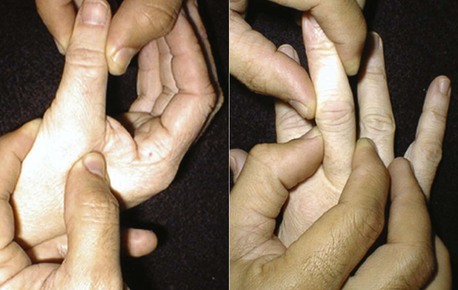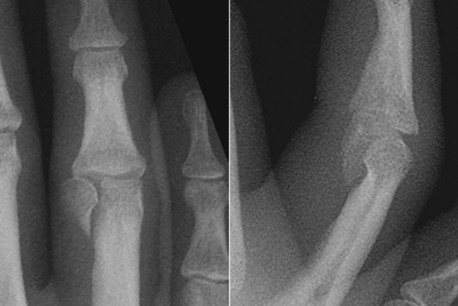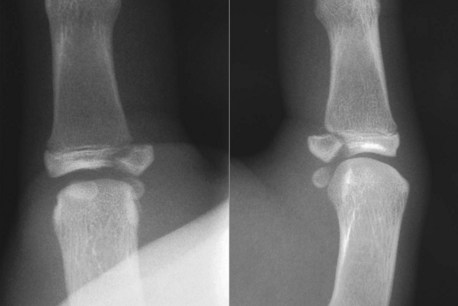Procedure 53 Metacarpophalangeal and Proximal Interphalangeal Joint Collateral Ligament Avulsion Fractures
![]() See Video 39: Metacarpal Shaft Fractures
See Video 39: Metacarpal Shaft Fractures
Indications
 Displaced collateral ligament with or without associated joint subluxation or dislocation
Displaced collateral ligament with or without associated joint subluxation or dislocation
 Large avulsion fragment with articular incongruity
Large avulsion fragment with articular incongruity
 Displaced and interposed fracture fragment within joint
Displaced and interposed fracture fragment within joint
 Border digit injury such as radial border of index finger or ulnar collateral ligament of thumb metaphalangeal (MP) joint
Border digit injury such as radial border of index finger or ulnar collateral ligament of thumb metaphalangeal (MP) joint
Examination/Imaging
Clinical Examination
 Unilateral swelling and bruising of the injured joint
Unilateral swelling and bruising of the injured joint
 Lateral deviation deformity of digit due to loss of collateral ligament integrity (Fig. 53-1)
Lateral deviation deformity of digit due to loss of collateral ligament integrity (Fig. 53-1)
 Pain with restricted range of motion
Pain with restricted range of motion
 Gentle testing of collateral ligaments to ensure integrity, which may require local anesthetic block. Avoid excessive force to prevent displacement of fragment (Fig. 53-2)
Gentle testing of collateral ligaments to ensure integrity, which may require local anesthetic block. Avoid excessive force to prevent displacement of fragment (Fig. 53-2)
 Patient asked to flex and extend the uninjured joints distal to the injury to evaluate the continuity of the flexor and extensor tendons
Patient asked to flex and extend the uninjured joints distal to the injury to evaluate the continuity of the flexor and extensor tendons
Imaging
 Posteroanterior, oblique, and true lateral films of the digit for proximal interphalangeal (PIP) joint injuries. At the PIP joint, the most common avulsion fracture is a unicondylar fracture (Fig. 53-3).
Posteroanterior, oblique, and true lateral films of the digit for proximal interphalangeal (PIP) joint injuries. At the PIP joint, the most common avulsion fracture is a unicondylar fracture (Fig. 53-3).
 Posteroanterior, oblique, and true lateral films of the hand for metacarpophalangeal (MCP) joint injuries (Fig. 53-4).
Posteroanterior, oblique, and true lateral films of the hand for metacarpophalangeal (MCP) joint injuries (Fig. 53-4).
 In the immature skeleton, ligament avulsion injuries occur at the growth plate with a fragment of the epiphysis (Fig. 53-5).
In the immature skeleton, ligament avulsion injuries occur at the growth plate with a fragment of the epiphysis (Fig. 53-5).
 Brewerton view provides a tangential view of the metacarpal head, demonstrating the area of origin of the collateral ligament, which will help to reveal small avulsion fragments from the metacarpal head.
Brewerton view provides a tangential view of the metacarpal head, demonstrating the area of origin of the collateral ligament, which will help to reveal small avulsion fragments from the metacarpal head.
 Computed tomography scanning is useful in cases of suspected involvement of the articular surface for evaluation of joint congruity.
Computed tomography scanning is useful in cases of suspected involvement of the articular surface for evaluation of joint congruity.
Surgical Anatomy
 MCP joint collateral ligaments are more commonly avulsed at their distal insertion. An avulsed fragment from the base of the proximal phalanx is lateral and volar to the midaxis.
MCP joint collateral ligaments are more commonly avulsed at their distal insertion. An avulsed fragment from the base of the proximal phalanx is lateral and volar to the midaxis.
 Rarely, in more severe injuries, with pure ligamentous avulsions or smaller fragment avulsions, the avulsed ligament lies superficial to the extensor apparatus.
Rarely, in more severe injuries, with pure ligamentous avulsions or smaller fragment avulsions, the avulsed ligament lies superficial to the extensor apparatus.
 If avulsed without bone or with a small fragment, the ulnar collateral ligament of the thumb MP joint can come to lie superficial to the adductor aponeurosis (Stener lesion).
If avulsed without bone or with a small fragment, the ulnar collateral ligament of the thumb MP joint can come to lie superficial to the adductor aponeurosis (Stener lesion).
Positioning
 The patient is positioned supine with the arm on a hand table.
The patient is positioned supine with the arm on a hand table.
 The forearm is pronated, and the hand is placed on a towel roll. The surgeon is seated facing the injured side of the digit.
The forearm is pronated, and the hand is placed on a towel roll. The surgeon is seated facing the injured side of the digit.
Exposures
Metacarpophalangeal Joint
 The MCP joint of the thumb and borders of the hand (ulnar side of small and radial side of index finger) can be easily accessed through a lateral approach.
The MCP joint of the thumb and borders of the hand (ulnar side of small and radial side of index finger) can be easily accessed through a lateral approach.
 Cutaneous nerves are located in the subcutaneous plane and must be identified and preserved.
Cutaneous nerves are located in the subcutaneous plane and must be identified and preserved.
 The oblique fibers of the extensor hood cover the MCP joint and will need to be incised longitudinally for access to the joint; they require meticulous repair on completion.
The oblique fibers of the extensor hood cover the MCP joint and will need to be incised longitudinally for access to the joint; they require meticulous repair on completion.
 Access to the MP collateral avulsion fracture for nonborder digits is achieved by a volar approach that allows reduction and fixation with compression.
Access to the MP collateral avulsion fracture for nonborder digits is achieved by a volar approach that allows reduction and fixation with compression.
 With a volar approach, the digital neurovascular bundle is at risk for injury and must be identified and carefully retracted away from the flexor tendon sheath.
With a volar approach, the digital neurovascular bundle is at risk for injury and must be identified and carefully retracted away from the flexor tendon sheath.
 A Bruner zigzag skin incision is made centered over the proximal digital crease (Fig. 53-6).
A Bruner zigzag skin incision is made centered over the proximal digital crease (Fig. 53-6).
 The flexor sheath is kept intact (Fig. 53-7
The flexor sheath is kept intact (Fig. 53-7
Stay updated, free articles. Join our Telegram channel

Full access? Get Clinical Tree












